Phase Composition, Nanohardness and Young’s Modulus in Ti-Fe Alloys after Heat Treatment and High Pressure Torsion
Abstract
:1. Introduction
2. Materials and Methods
3. Results
4. Discussion
5. Conclusions
Author Contributions
Funding
Data Availability Statement
Acknowledgments
Conflicts of Interest
References
- Donachie, M.J., Jr. Titanium: A Technical Guide, 2nd ed.; ASM International: Materials Park, OH, USA, 2000. [Google Scholar]
- Chen, W.; Xu, J.; Liu, D.; Bao, J.; Sabbaghianrad, S.; Shan, D.; Guo, B.; Langdon, T.G. Microstructural evolution and microhardness variations in pure titanium processed by high-pressure torsion. Adv. Eng. Mater. 2020, 22, 1901462. [Google Scholar] [CrossRef]
- Deng, G.; Bhattacharjee, T.; Chong, Y.; Zheng, R.; Bai, Y.; Shibata, A.; Tsuji, N. Characterization of microstructure and mechanical property of pure titanium with different Fe addition processed by severe plastic deformation and subsequent annealing. In IOP Conference Series: Materials Science and Engineering; IOP Publishing: Bristol, UK, 2017; Volume 194, p. 012020. [Google Scholar] [CrossRef] [Green Version]
- Korneva, A.; Straumal, B.; Kilmametov, A.; Gondek, Ł.; Wierzbicka-Miernik, A.; Litynska-Dobrzynska, L.; Cios, G.; Chulist, R.; Zieba, P. Thermal stability and microhardness of metastable ω-phase in the Ti-3.3 at.% Co alloy subjected to high pressure torsion. J. Alloys Compod. 2020, 834, 155132. [Google Scholar] [CrossRef]
- Mohan, P.; Rajak, D.K.; Pruncu, C.I.; Behera, A.; Amig’o-Borrás, V.; Elshalakany, A.B. Influence of β-phase stability in elemental blended Ti-Mo and Ti-Mo-Zr alloys. Micron 2021, 142, 102992. [Google Scholar] [CrossRef] [PubMed]
- Zhang, W.D.; Liu, Y.; Wu, H.; Song, M.; Zhang, T.Y.; Lan, X.D.; Yao, T.H. Elastic modulus of phases in Ti–Mo alloys. Mater. Charact. 2015, 106, 302–307. [Google Scholar] [CrossRef]
- Errandonea, D.; Meng, Y.; Somayazulu, M.; Häusermann, D. Pressure-induced alpha-to-omega transition in titanium metal: A systematic study of the effects of uniaxial stress. Phys. B 2005, 355, 116–125. [Google Scholar] [CrossRef] [Green Version]
- Trinkle, D.R.; Hennig, R.G.; Srinivasan, S.G.; Hatch, D.M.; Jones, M.D.; Stokes, H.T.; Albers, R.C.; Wilkins, J.W. New mechanism for the alpha to omega martensitic transformation in pure titanium. Phys. Rev. Lett. 2003, 91, 025701. [Google Scholar] [CrossRef] [Green Version]
- Kriegel, M.J.; Kilmametov, A.; Rudolph, M.; Straumal, B.B.; Gornakova, A.S.; Stöcker, H.; Ivanisenko, Y.; Fabrichnaya, O.; Hahn, H.; Rafaja, D. Transformation pathway upon heating of Ti–Fe alloys deformed by high-pressure torsion. Adv. Eng. Mater. 2018, 20, 1700933. [Google Scholar] [CrossRef]
- Kriegel, M.J.; Kilmametov, A.; Klemm, V.; Schimpf, C.; Straumal, B.B.; Gornakova, A.S.; Ivanisenko, Y.; Fabrichnaya, O.; Hahn, H.; Rafaja, D. Thermal stability of athermal ω-Ti(Fe) produced upon quenching of β-Ti(Fe). Adv. Eng. Mater. 2019, 21, 1800158. [Google Scholar] [CrossRef] [Green Version]
- Kriegel, M.J.; Rudolph, M.; Kilmametov, A.; Straumal, B.B.; Ivanisenko, J.; Fabrichnaya, O.; Hahn, H.; Rafaja, D. Formation and thermal stability of ω-Ti(Fe) in α-phase-based Ti(Fe) alloys. Metals 2020, 10, 402. [Google Scholar] [CrossRef] [Green Version]
- Korneva, A.; Straumal, B.B.; Kilmametov, A.R.; Gondek, Ł.; Wierzbicka-Miernik, A.; Lityńska-Dobrzyńska, L.; Chulist, R.; Cios, G.; Zięba, P. The α↔ω phase transformations and thermal stability 2194 of Ti–Co alloy treated by high pressure torsion. Mater. Charact. 2021, 80, 110937. [Google Scholar] [CrossRef]
- Sikka, S.K.; Vohra, Y.K.; Chidambaram, R. Omega-phase in materials. Prog. Mater. Sci. 1982, 27, 245–310. [Google Scholar] [CrossRef]
- Banerjee, S.; Mukhopadhyay, P. Phase Transformations: Examples from Titanium and Zirconium Alloy; Elsevier: Amsterdam, The Netherlands, 2010. [Google Scholar]
- Hickman, B.S. The formation of omega phase in Ti and Zr alloys: A review. J. Mater. Sci. 1969, 4, 554–563. [Google Scholar] [CrossRef]
- Scientific Group Thermodata Europe (SGTE). Thermodynamic Properties of Inorganic Materials. In Landolt-Börnstein; Springer: Berlin/Heidelberg, Germany, 2005; Volume 19, Group IV (Physical Chemistry). [Google Scholar]
- Edalati, K.; Matsuda, J.; Arita, M.; Daio, T.; Akiba, E.; Horita, Z. Mechanism of activation of TiFe intermetallics for hydrogen storage by severe plastic deformation using high-pressure torsion. Appl. Phys. Lett. 2013, 103, 143902. [Google Scholar] [CrossRef]
- Edalati, K.; Matsubara, E.; Horita, Z. Processing pure Ti by high-pressure torsion in wide ranges of pressure and strain. Metall. Mater. Trans. A 2009, 40, 2079–2086. [Google Scholar] [CrossRef]
- Edalati, K.; Daio, T.; Arita, M.; Lee, S.; Horita, Z.; Togo, A.; Tanaka, I. High pressure torsion of titanium at cryogenic and room temperatures: Grain size effect on allotropic phase transformation. Acta Mater. 2014, 68, 207–213. [Google Scholar] [CrossRef]
- Wang, C.T.; Fox, A.G.; Langdon, T.G. Microstructural evolution in ultrafinegrained titanium processed by high-pressure torsion under different pressures. J. Mater. Sci. 2014, 49, 6558–6564. [Google Scholar] [CrossRef]
- Sinha, S.; Sahu, V.K.; Beura, V.; Sonkusare, R.; Kalsar, R.; Das, A.K.L.; Basu, J.; Gurao, N.P.; Biswas, K. Initial texture dependence of nanocrystalline omega phase formation during high pressure torsion of commercially pure titanium. Mater. Sci. Eng. A 2021, 802, 140687. [Google Scholar] [CrossRef]
- Straumal, B.; Korneva, A.; Zięba, P. Phase transitions in metallic alloys driven by the high pressure torsion. Arch. Civ. Mech. Eng. 2014, 14, 242–249. [Google Scholar] [CrossRef]
- Valiev, R.Z.; Islamgaliev, R.K.; Alexandrov, I. Bulk nanostructured materials from severe plastic deformation. Prog. Mater. Sci. 2000, 45, 103–189. [Google Scholar] [CrossRef]
- Straumal, B.B.; Baretzky, B.; Mazilkin, A.A.; Phillipp, F.; Kogtenkova, O.A.; Volkov, M.N.; Valiev, R.Z. Formation of nanograined structure and decomposition of supersaturated solid solution during high pressure torsion of Al–Zn and Al–Mg. Acta Mater. 2004, 52, 4469–4478. [Google Scholar] [CrossRef]
- Mazilkin, A.A.; Straumal, B.B.; Rabkin, E.; Baretzky, B.; Enders, S.; Protasova, S.G.; Kogtenkova, O.A.; Valiev, R.Z. Softening of nanostructured Al–Zn and Al–Mg alloys after severe plastic deformation. Acta Mater. 2006, 54, 3933–3939. [Google Scholar] [CrossRef]
- Straumal, B.B.; Protasova, S.G.; Mazilkin, A.A.; Rabkin, E.; Goll, D.; Schütz, G.; Baretzky, B.; Valiev, R. Deformation-driven formation of equilibrium phases in the Cu–Ni alloys. J. Mater. Sci. 2012, 47, 360–367. [Google Scholar] [CrossRef]
- Straumal, B.B.; Kilmametov, A.R.; Kucheev, Y.O.; Kurmanaeva, L.; Ivanisenko, Y.; Baretzky, B.; Korneva, A.; Zięba, P.; Molodov, D.A. Phase transitions during high pressure torsion of Cu–Co alloys. Mater. Lett. 2014, 118, 111–114. [Google Scholar] [CrossRef]
- Straumal, B.; Valiev, R.; Kogtenkova, O.; Zięba, P.; Czeppe, T.; Bielanska, E.; Faryna, M. Thermal evolution and grain boundary phase transformations in severe deformed nanograined Al–Zn alloys. Acta Mater. 2008, 56, 6123–6131. [Google Scholar] [CrossRef]
- Lojkowski, W.; Djahanbakhsh, M.; Burkle, G.; Gierlotka, S.; Zielinski, W.; Fecht, H.J. Nanostructure formation on the surface of railway tracks. Mater. Sci. Eng. A 2001, 303, 197–208. [Google Scholar] [CrossRef]
- Gavriljuk, V.G. Decomposition of cementite in pearlitic steel due to plastic deformation. Mater. Sci. Eng. A 2003, 345, 81–89. [Google Scholar] [CrossRef]
- Sauvage, X.; Wetscher, F.; Pareige, P. Mechanical alloying of Cu and Fe induced by severe plastic deformation of a Cu–Fe composite. Acta Mater. 2005, 53, 2127–2135. [Google Scholar] [CrossRef] [Green Version]
- Glezer, A.M.; Plotnikova, M.R.; Shalimova, A.V.; Dobatkin, S.V. Severe plastic deformation of amorphous alloys: I. Structure and mechanical properties. Bull. Russ. Acad. Sci. Phys. 2009, 73, 1233–1236. [Google Scholar] [CrossRef]
- Abrosimova, G.E.; Aronin, A.S.; Dobatkin, S.V.; Kaloshkin, S.D.; Matveev, D.V.; Rybchenko, O.G.; Tatyanin, E.V.; Zverkova, I.I. The formation of nanocrystalline structure in amorphous Fe-Si-B alloy by severe plastic deformation. J. Metastab. Nanocryst. Mater. 2005, 24, 69–72. [Google Scholar] [CrossRef]
- Henits, P.; Révész, Á.; Zhilyaev, A.P.; Kovács, Z. Severe plastic deformation induced nanocrystallization of melt-spun Al85Y8Ni5Co2 amorphous alloy. J. Alloys Comp. 2008, 461, 195–199. [Google Scholar] [CrossRef]
- Cepeda-Jiménez, C.M.; García-Infanta, J.M.; Zhilyaev, A.P.; Ruano, O.A.; Carreño, F. Influence of the thermal treatment on the deformation-induced precipitation of a hypoeutectic Al–7 wt% Si casting alloy deformed by high-pressure torsion. J. Alloys Comp. 2011, 509, 636–643. [Google Scholar] [CrossRef] [Green Version]
- Ivanisenko, Y.; Lojkowski, W.; Valiev, R.Z.; Fecht, H.J. The mechanism of formation of nanostructure and dissolution of cementite in a pearlitic steel during high pressure torsion. Acta Mater. 2003, 51, 5555–5570. [Google Scholar] [CrossRef]
- Straumal, B.B.; Mazilkin, A.A.; Protasova, S.G.; Dobatkin, S.V.; Rodin, A.O.; Baretzky, B.; Goll, D.; Schütz, G. Fe–C nanograined alloys obtained by high pressure torsion: Structure and magnetic properties. Mater. Sci. Eng. A 2009, 503, 185–189. [Google Scholar] [CrossRef]
- Sagaradze, V.V.; Shabashov, V.A. Deformation-induced anomalous phase transformations in nanocrystalline FCC Fe–Ni based alloys. Nanostruct. Mater. 1997, 9, 681–684. [Google Scholar] [CrossRef]
- Ohsaki, S.; Kato, S.; Tsuji, N.; Ohkubo, T.; Hono, K. Bulk mechanical alloying of Cu–Ag and Cu/Zr two-phase microstructures by accumulative roll-bonding process. Acta Mater. 2007, 55, 2885–2895. [Google Scholar] [CrossRef]
- Straumal, B.B.; Dobatkin, S.V.; Rodin, A.O.; Protasova, S.G.; Mazilkin, A.A.; Goll, D.; Baretzky, B. Structure and properties of nanograined Fe–C alloys after severe plastic deformation. Adv. Eng. Mater. 2011, 13, 463–469. [Google Scholar] [CrossRef]
- Sergueeva, A.V.; Song, C.; Valiev, R.Z.; Mukherjee, A.K. Structure and properties of amorphous and nanocrystalline NiTi prepared by severe plastic deformation and annealing. Mater. Sci. Eng. A 2003, 339, 159–165. [Google Scholar] [CrossRef]
- Prokoshkin, S.D.; Khmelevskaya, I.Y.; Dobatkin, S.V.; Trubitsyna, I.B.; Tatyanin, E.V.; Stolyarov, V.V.; Prokofiev, E.A. Alloy composition, deformation temperature, pressure and post-deformation annealing effects in severely deformed Ti-Ni based shape memory alloys. Acta Mater. 2005, 53, 2703–2714. [Google Scholar] [CrossRef]
- Sauvage, X.; Renaud, L.; Deconihout, B.; Blavette, D.; Ping, D.H.; Hono, K. Solid state amorphization in cold drawn Cu/Nb wires. Acta Mater. 2001, 49, 389–394. [Google Scholar] [CrossRef]
- Miyazaki, T.; Terada, D.; Miyajima, Y.; Suryanarayana, C.; Murao, R.; Yokoyama, Y.; Sugiyama, K.; Umemoto, M.; Todaka, T.; Tsuji, N. Synthesis of non-equilibrium phases in immiscible metals mechanically mixed by high pressure torsion. J. Mater. Sci. 2011, 46, 4296–4301. [Google Scholar] [CrossRef]
- Mazilkin, A.A.; Abrosimova, G.E.; Protasova, S.G.; Straumal, B.B.; Schütz, G.; Dobatkin, S.V.; Bakai, A.S. Transmission electron microscopy investigation of boundaries between amorphous “grains” in Ni50Nb20Y30 alloy. J. Mater. Sci. 2011, 46, 4336–4342. [Google Scholar] [CrossRef]
- Straumal, B.B.; Mazilkin, A.A.; Protasova, S.G.; Goll, D.; Baretzky, B.; Bakai, A.S.; Dobatkin, S.V. Formation of two amorphous phases in the Ni60Nb18Y22 alloy after high pressure torsion. Kovove Mater.–Metall. Mater. 2011, 49, 17–22. [Google Scholar] [CrossRef]
- Straumal, B.B.; Kilmametov, A.R.; Ivanisenko, Y.; Mazilkin, A.A.; Kogtenkova, O.A.; Kurmanaeva, L.; Korneva, A.; Zięba, P.; Baretzky, B. Phase transitions induced by severe plastic deformation: Steady-state and equifinality. Int. J. Mater. Res. 2015, 106, 657–664. [Google Scholar] [CrossRef]
- Straumal, B.B.; Kilmametov, A.R.; Ivanisenko, Y.; Gornakova, A.S.; Mazilkin, A.A.; Kriegel, M.J.; Fabrichnaya, O.B.; Baretzky, B.; Hahn, H. Phase transformations in Ti-Fe alloys induced by high pressure torsion. Adv. Eng. Mater. 2015, 17, 1835–1841. [Google Scholar] [CrossRef]
- Gornakova, A.S.; Straumal, A.B.; Khodos, I.I.; Gnesin, I.B.; Mazilkin, A.A.; Afonikova, N.S.; Straumal, B.B. Effect of composition, annealing temperature and high pressure torsion on structure and hardness of Ti–V and Ti–V–Al alloys. J. Appl. Phys. 2019, 125, 082522. [Google Scholar] [CrossRef]
- Straumal, B.B.; Pontikis, V.; Kilmametov, A.R.; Mazilkin, A.A.; Dobatkin, S.V.; Baretzky, B. Competition between precipitation and dissolution in Cu–Ag alloys under high pressure torsion. Acta Mater. 2017, 122, 60–71. [Google Scholar] [CrossRef]
- Zaher, G.; Lomakin, I.; Enikeev, N.; Jouen, S.; Saiter-Fourcin, A.; Sauvage, X. Influence of strain rate and Sn in solid solution on the grain refinement and crystalline defect density in severely deformed Cu. Mater. Today Commun. 2021, 26, 101746. [Google Scholar] [CrossRef]
- Huang, C.X.; Yang, G.; Gao, Y.L.; Wu, S.D.; Li, S.X. Investigation on the nucleation mechanism of deformation-induced martensite in an austenitic stainless steel under severe plastic deformation. J. Mater. Res. 2007, 22, 724–729. [Google Scholar] [CrossRef]
- Waitz, T.; Pranger, W.; Antretter, T.; Fischer, F.D.; Karnthaler, H.P. Competing accommodation mechanisms of the martensite in nanocrystalline NiTi shape memory alloys. Mater. Sci. Eng. A 2008, 481–482, 479–483. [Google Scholar] [CrossRef]
- Jiang, S.; Zhang, Y.; Zhao, L.; Zheng, Y. Influence of annealing on NiTi shape memory alloy subjected to severe plastic deformation. Intermetallics 2013, 32, 344–351. [Google Scholar] [CrossRef]
- Ivanisenko, Y.; Kilmametov, A.; Roesner, H.; Valiev, R.Z. Evidence of α→ω phase transition in titanium after high pressure torsion. Int. J. Mater. Res. 2008, 99, 36–41. [Google Scholar] [CrossRef]
- Straumal, B.B.; Kilmametov, A.R.; López, G.A.; López-Ferreño, I.; Nó, M.L.; San Juan, J.; Hahn, H.; Baretzky, B. High-pressure torsion driven phase transformations in Cu–Al–Ni shape memory alloys. Acta Mater. 2017, 125, 274–285. [Google Scholar] [CrossRef]
- Straumal, B.B.; Gornakova, A.S.; Mazilkin, A.A.; Fabrichnaya, O.B.; Kriegel, M.J.; Baretzky, B.; Jiang, J.-Z.; Dobatkin, S.V. Phase transformations in the severely plastically deformed Zr–Nb alloys. Mater. Lett. 2012, 81, 225–228. [Google Scholar] [CrossRef]
- Valiev, R.Z. Nanostructuring of metals by severe plastic deformation for advanced properties. Nat. Mater. 2004, 3, 511–516. [Google Scholar] [CrossRef] [PubMed]
- Valiev, R.Z.; Alexandrov, I.V.; Zhu, Y.T.; Lowe, T.C. Paradox of strength and ductility in metals processed by severe plastic deformation. J. Mater. Res. 2002, 17, 5–8. [Google Scholar] [CrossRef] [Green Version]
- Korneva, A.; Straumal, B.; Kilmametov, A.; Gornakova, A.; Wierzbicka-Miernik, A.; Lityńska-Dobrzyńska, L.; Chulist, R.; Gondek, Ł.; Cios, G.; Zięba, P. Omega phase formation in Ti–3wt.%Nb alloy induced by high-pressure torsion. Materials 2021, 14, 2262. [Google Scholar] [CrossRef]
- Rogachev, S.O.; Nikulin, S.A.; Rozhnov, A.B.; Gorshenkov, M.V. Microstructure, Phase composition, and thermal stability of two zirconium alloys subjected to high-pressure torsion at different temperatures. Adv. Eng. Mater. 2018, 20, 1800151. [Google Scholar] [CrossRef]
- Kao, Y.L.; Tu, G.C.; Huang, C.A.; Liu, T.T. A study on the hardness variation of α- and β-pure titanium with different grain sizes. Mater. Sci. Eng. A 2005, 398, 93–98. [Google Scholar] [CrossRef]
- Kilmametov, A.; Ivanisenko, Y.; Mazilkin, A.; Straumal, B.; Gornakova, A.; Fabrichnaya, O.; Kriegel, M.; Rafaja, D.; Hahn, H. The α→ω and β→ω phase transformations in Ti–Fe alloys under high-pressure torsion. Acta Mater. 2018, 144, 337–351. [Google Scholar] [CrossRef]
- Gupta, S.C.; Joshi, K.D.; Banerjee, S. Experimental and theoretical investigations on d and f electron systems under high pressure. Metall. Mater. Trans. A 2008, 39, 1593–1601. [Google Scholar] [CrossRef]
- Hennig, R.; Trinkle, D.R.; Bouchet, J.; Srinivasan, S.G.; Albers, R.C.; Wilkins, J.W. Impurities block the alpha to omega martensitic transformation in titanium. Nat. Mater. 2005, 4, 129–133. [Google Scholar] [CrossRef] [Green Version]
- Afonikova, N.S.; Degtyareva, V.F.; Litvin, Y.A.; Rabinkin, A.G.; Skakov, Y.A. Superconductivity and crystal structure of Ti-Nb alloys after high-pressure action up 120 kbar. Sov. Phys. Sol. State 1973, 15, 746–749. [Google Scholar]
- Vohra, Y.K.; Sikka, S.K.; Menon, E.S.K.; Krishnan, R. High-pressure studies on a prototype omega forming alloy system. Acta Metall. 1981, 29, 457–470. [Google Scholar] [CrossRef]
- Dey, G.K.; Tewari, R.; Banerjee, S.; Jyoti, G.; Gupta, S.C.; Joshi, K.D.; Sikka, S.K. Formation of a shock deformation induced omega phase in Zr20Nb alloy. Acta Mater. 2004, 52, 5243–5254. [Google Scholar] [CrossRef]
- Gornakova, A.S.; Straumal, B.B.; Golovin, Y.I.; Afonikova, N.S.; Pirozhkova, T.S.; Tyurin, A.I. Phase transformations and mechanical properties of two-component titanium alloys after heat treatment in the two-phase region (α + TiMe) and HPT. J. Surf. Investig. X-Ray Synch. Neutron Tech. 2021, 11, 1–6. [Google Scholar] [CrossRef]
- Golovin, Y.I. Nanoindentation and mechanical properties of materials at submicro- and nanoscale levels: Recent results and achievements. Phys. Solid State 2021, 63, 1–41. [Google Scholar] [CrossRef]
- Golovin, Y.I.; Tyurin, A.I.; Aslanyan, E.G.; Pirozhkova, T.S.; Vasyukov, V.M. The physical and mechanical properties and local deformation micromechanisms in materials with different dependence of hardness on the depth of print. Phys. Solid State 2017, 59, 1803–1811. [Google Scholar] [CrossRef]
- Golovin, Y.I.; Tyurin, A.I.; Iunin, Y.L. Strain-rate sensitivity of the hardness of crystalline materials under dynamic nanoindentation. Dokl. Phys. 2003, 48, 505–511. [Google Scholar] [CrossRef]
- Chong, Y.; Zheng, R.; Deng, G.; Shibata, A.; Tsuji, N. Investigation on the microstructure and mechanical properties of Ti–1.0Fe alloy with equiaxed α + β microstructures. Metall. Mater. Trans. A 2020, 51A, 2851–2863. [Google Scholar] [CrossRef]
- Chong, Y.; Deng, G.; Shibata, A.; Tsuji, N. Microstructure evolution and phase transformation of Ti–1.0 wt%Fe alloy with an equiaxed α + β initial microstructure during high-pressure torsion and subsequent annealing. Adv. Eng. Mater. 2019, 21, 1900607. [Google Scholar] [CrossRef]
- Verestiuc, L.; Spataru, M.-C.; Baltatu, M.S.; Butnaru, M.; Solcan, C.; Sandu, A.V.; Voiculescu, I.; Geanta, V.; Vizureanu, P. New Ti–Mo–Si materials for bone prosthesis applications. J. Mech. Behav. Biomed. Mater. 2021, 113, 104198. [Google Scholar] [CrossRef] [PubMed]
- Tane, M.; Okuda, Y.; Todaka, Y.; Ogi, H.; Nagakubo, A. Elastic properties of single-crystalline x phase in titanium. Acta Mater. 2013, 61, 7543–7554. [Google Scholar] [CrossRef]
- Straumal, B.B.; Korneva, A.; Kilmametov, A.R.; Lityńska-Dobrzyńska, L.; Gornakova, A.S.; Chulist, R.; Karpov, M.I.; Ziȩba, P. Structural and mechanical properties of Ti–Co alloys treated by high pressure torsion. Materials 2019, 12, 426. [Google Scholar] [CrossRef] [PubMed] [Green Version]
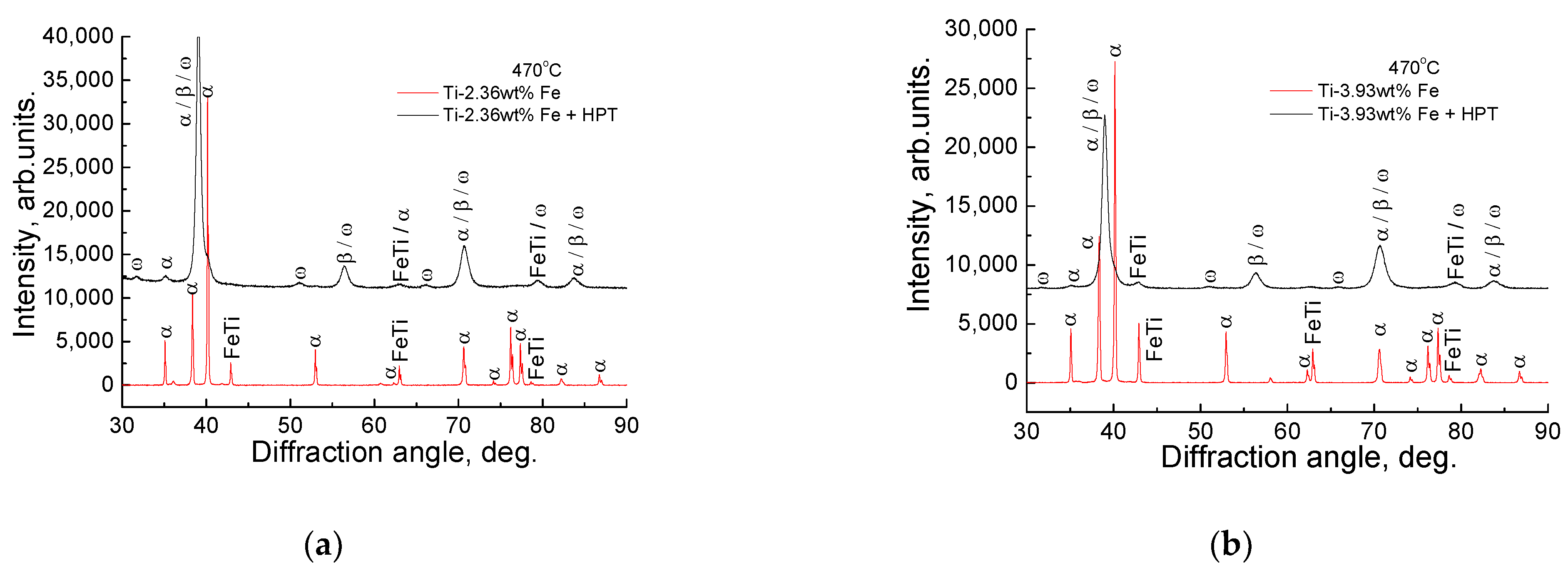
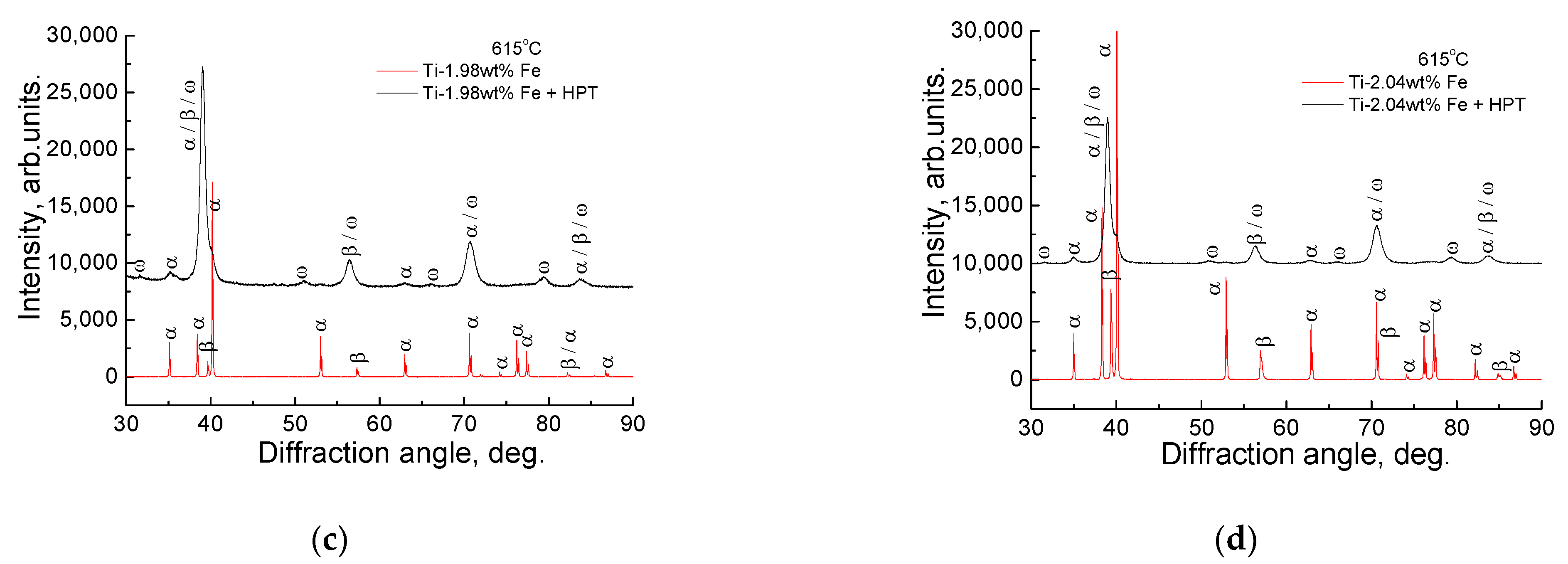

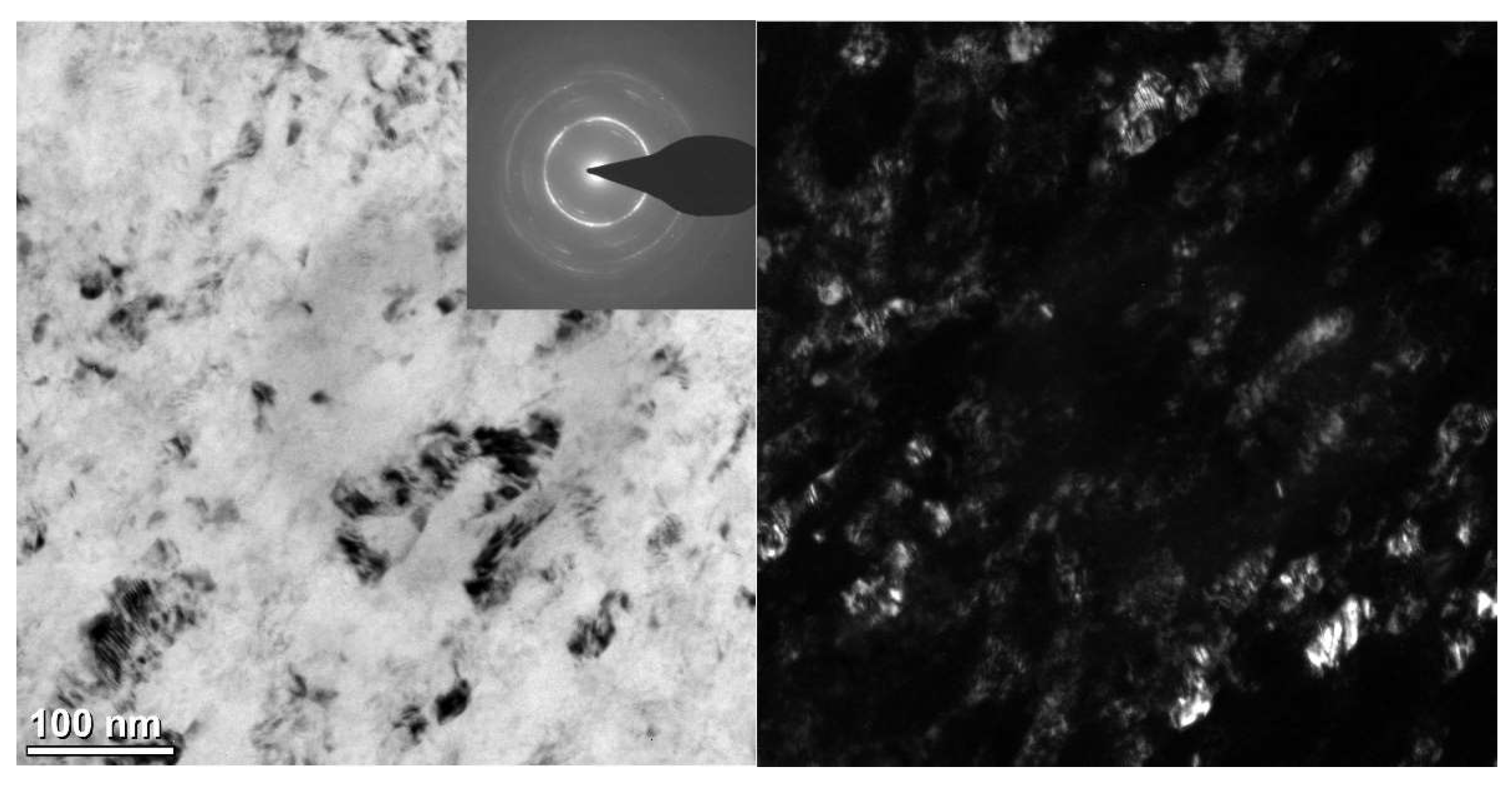
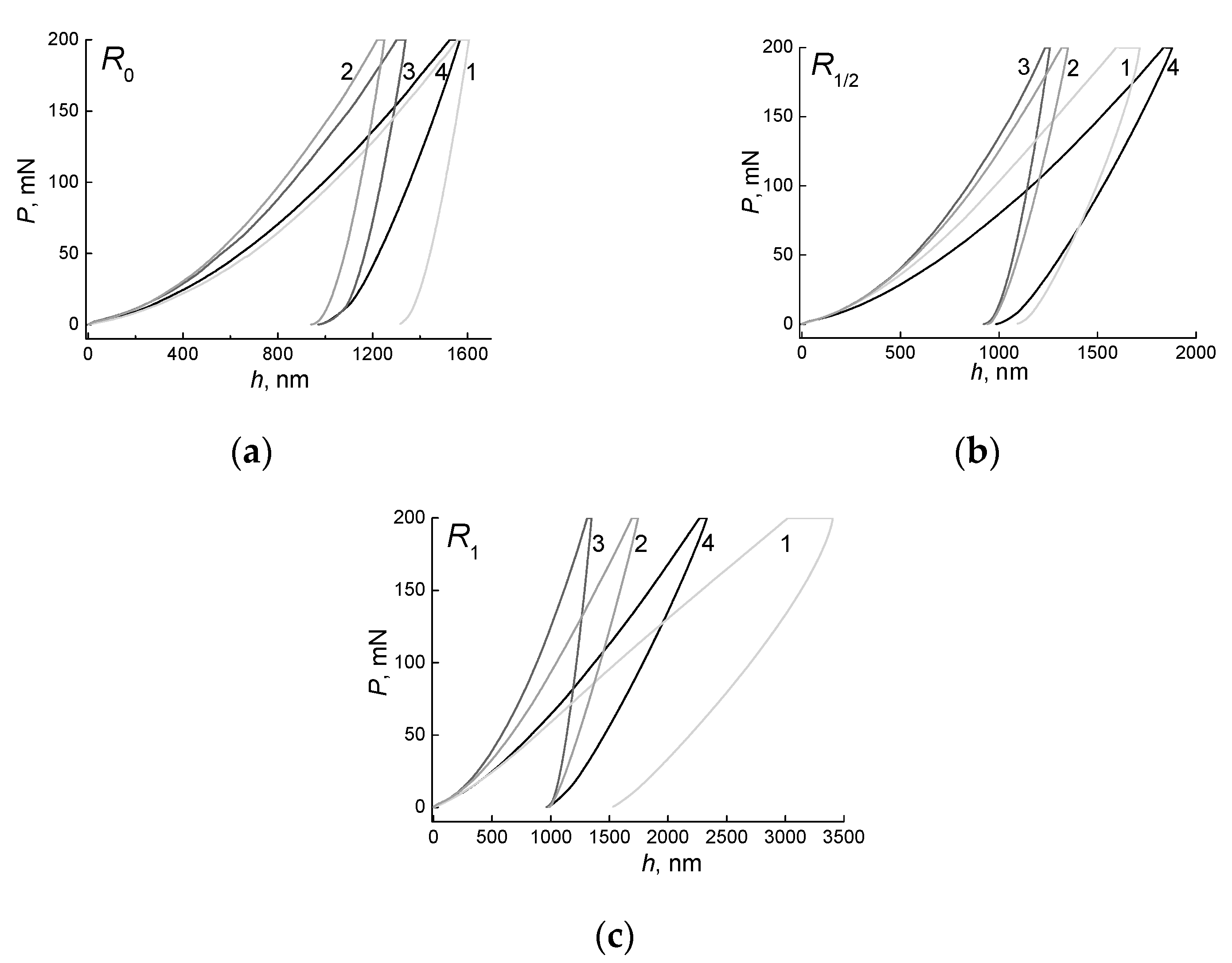
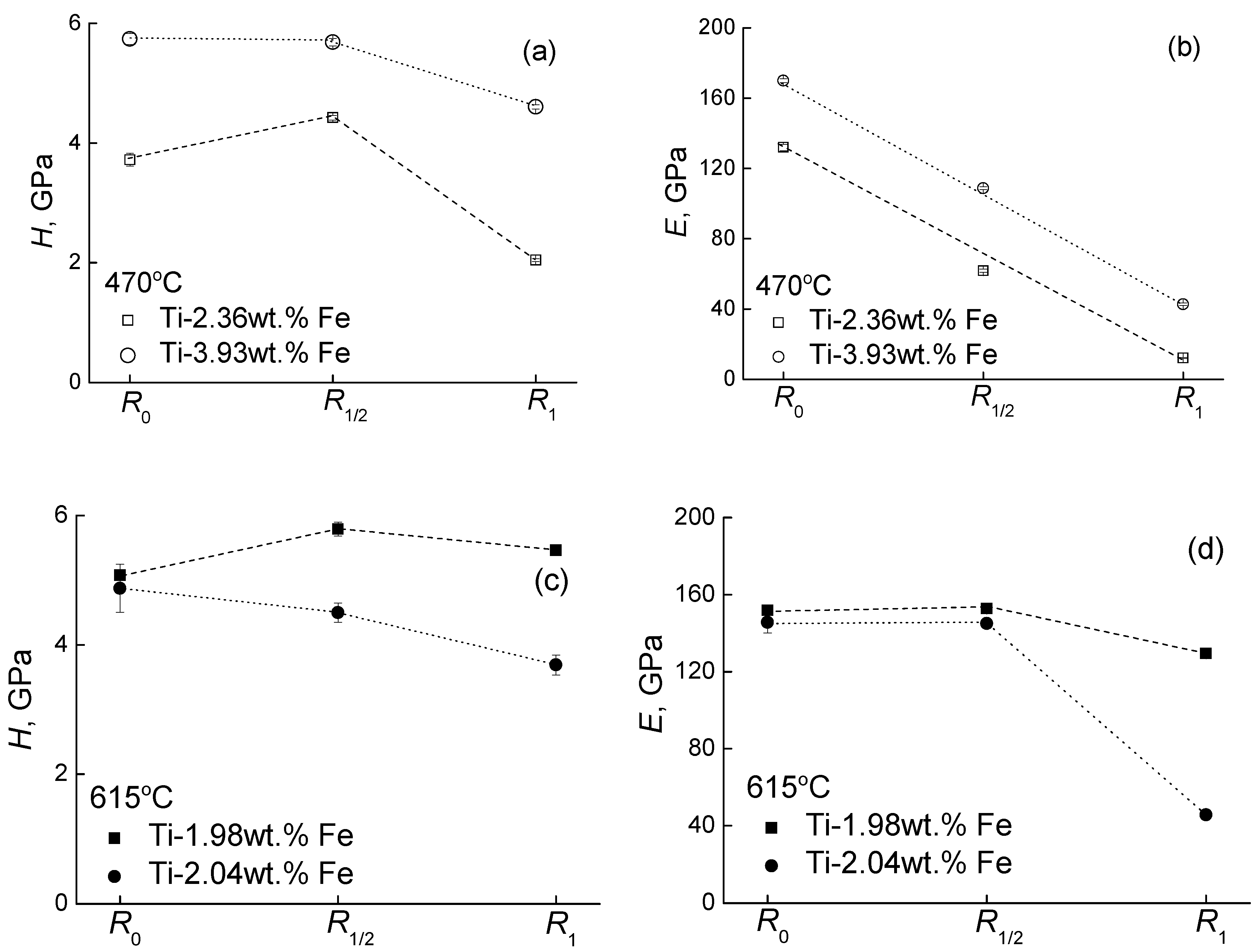
| Iron Content, wt.% Fe | Phase Diagram Area | αTi | βTi | TiFe | |||
|---|---|---|---|---|---|---|---|
| V, % | a, c, nm | V, % | a, nm | V, % | c, a, nm | ||
| 1.98 ± 0.12 | α + β | 95 | 0.2950, 0.4686 | 5 | 0.3216 | - | - |
| 2.04 ± 0.07 | α + β | 85 | 0.2948, 0.4682 | 15 | 0.3226 | - | - |
| 2.36 ± 0.03 | α + TiFe | 97 | 0.2950, 0.4687 | - | - | 3 | 0.2978 |
| 3.93 ± 0.21 | α + TiFe | 92 | 0.2950, 0.4688 | - | - | 8 | 0.2976 |
| Ti [63] | - | - | 0.2955, 0.4694 | - | |||
| Iron Content, wt.% Fe | Phase Diagram Area | αTi | βTi | ωTi | TiFe | ||||
|---|---|---|---|---|---|---|---|---|---|
| V, % | a, c, nm | V, % | a, nm | V, % | c, a, nm | V, % | a, nm | ||
| 1.98 ± 0.12 | α + β | 10 | 0.2952, 0.4693 | 11 | 0.3256 | 79 | 0.4626, 0.2814 | - | - |
| 2.04 ± 0.07 | α + β | 12 | 0.2950, 0.4684 | 1 | 0.3252 | 87 | 0.4630, 0.2812 | - | - |
| 2.36 ± 0.03 | α + TiFe | 8 | 0.2950, 0.4690 | 16 | 0.3255 | 76 | 0.4626, 0.2814 | - | - |
| 3.93 ± 0.21 | α + TiFe | 7.5 | 0.2950, 0.4688 | - | - | 92 | 0.4627, 0.2812 | 0.5 | 0.2980 |
| Ti [63] | – | - | 0.2959, 0.4690 | - | - | - | - | - | - |
Publisher’s Note: MDPI stays neutral with regard to jurisdictional claims in published maps and institutional affiliations. |
© 2021 by the authors. Licensee MDPI, Basel, Switzerland. This article is an open access article distributed under the terms and conditions of the Creative Commons Attribution (CC BY) license (https://creativecommons.org/licenses/by/4.0/).
Share and Cite
Gornakova, A.S.; Straumal, B.B.; Mazilkin, A.A.; Afonikova, N.S.; Karpov, M.I.; Novikova, E.A.; Tyurin, A.I. Phase Composition, Nanohardness and Young’s Modulus in Ti-Fe Alloys after Heat Treatment and High Pressure Torsion. Metals 2021, 11, 1657. https://doi.org/10.3390/met11101657
Gornakova AS, Straumal BB, Mazilkin AA, Afonikova NS, Karpov MI, Novikova EA, Tyurin AI. Phase Composition, Nanohardness and Young’s Modulus in Ti-Fe Alloys after Heat Treatment and High Pressure Torsion. Metals. 2021; 11(10):1657. https://doi.org/10.3390/met11101657
Chicago/Turabian StyleGornakova, Alena S., Boris B. Straumal, Andrey A. Mazilkin, Natalia S. Afonikova, Mikhail I. Karpov, Elena A. Novikova, and Alexander I. Tyurin. 2021. "Phase Composition, Nanohardness and Young’s Modulus in Ti-Fe Alloys after Heat Treatment and High Pressure Torsion" Metals 11, no. 10: 1657. https://doi.org/10.3390/met11101657
APA StyleGornakova, A. S., Straumal, B. B., Mazilkin, A. A., Afonikova, N. S., Karpov, M. I., Novikova, E. A., & Tyurin, A. I. (2021). Phase Composition, Nanohardness and Young’s Modulus in Ti-Fe Alloys after Heat Treatment and High Pressure Torsion. Metals, 11(10), 1657. https://doi.org/10.3390/met11101657







